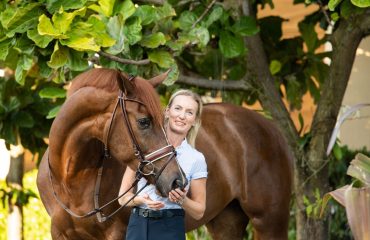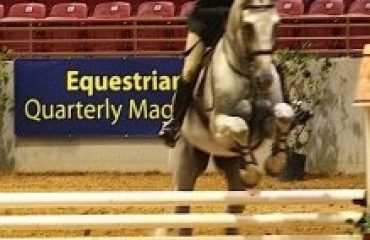By Laura Scaletti
Portraits by Susan McClafferty

Horse girls never forget the magic of owning and loving their first horse; it’s this early love that turns horse girls into lifelong equestrians. Karen Rohlf’s first horse, Chessie, not only left a lasting impression on her heart, but he also inspired her to devote her life to putting horses first.
The love for horses was solid from the start for Karen, a shy child. “I always felt more sense of belonging when in the presence of animals. From the time I was 7 years old, my mom let me ride bareback and spend a lot of time alone with her horse and I always felt at peace with him,” Karen said. “There’s an amazing feeling of acceptance you can get from a horse.”
When Karen was 12, her parents finally gave in to her pleas and bought her Chessie. “He was perfect for me. We did lots of crazy kid stuff and were introduced to eventing through Pony Club. After three years together, I found bigger goals that weren’t appropriate for Chessie and made the decision to sell him to a neighborhood friend who kept him at the same barn,” she said.
Unfortunately, his new owner also had goals that went beyond his capabilities. “I don’t blame his new owner; she was a kid younger than me, she was just doing what her instructor told her. However, I saw firsthand how Chessie’s personality and behavior changed for the worse when he was pushed to do things he couldn’t do. It became clear that the choices we make about what we ask horses to do for us have a huge impact on their life experience and how they act,” Karen said. “It hurt my heart and made a big impression on me. Chessie taught me that I am responsible for my horse’s life experience.”
While Chessie sparked the belief that Karen is responsible for her horses’ lives, as she saw more horses labeled as “bad” simply because they couldn’t do what was asked of them, she wondered how they would act if they were given a happy life. This led Karen to creating her Dressage Naturally program and the corresponding Happy Athlete Training Scale.
 Finding Dressage
Finding Dressage
While in Pony Club with Chessie, Karen was invited to go foxhunting with the local hunt. Chessie ended up creating quite the scene as he took off, passed everyone and galloped through the middle of the hounds. “The huntsman had to gallop after me and grab the reins. He led me up to my mom and said, ‘Take this girl for some dressage lessons so she can learn how to control her horse.’ So she did,” Karen said.
It just so happened the only dressage near Karen was Knoll Farm, owned by legendary dressage rider and trainer Anne Gribbons. Karen began taking lessons from one of the instructors and was immediately amazed that one could make a horse go sideways via leg yields.
Karen continued to take lessons at Knoll Farm with her second horse, Brave Tom. “When my instructor left to have a child, Anne said, ‘I’ll take the skinny kid on the Thoroughbred.’ I was only doing dressage because it was part of eventing. I was so lucky to have landed with Anne. She took me and Brave Tom from nothing all the way up the levels. We represented the USA on the Young Rider’s team four years in a row, resulting in team silver three times and once earning individual bronze,” she said.
With just weekly lessons at Knoll Farm, Karen did most of her dressage training on trails while home alone. “I was fascinated by the process of teaching the movement and at the precision. I could feel the difference when my horse started becoming supple and engaged,” Karen said. “I became obsessed with the feeling of power and moving so much as one.”
As Karen moved up the levels in dressage, she was still doing Pony Club and eventing. Prior to competing at the Prix St. Georges level, Anne told her it was time to choose what she was going to focus on: dressage or eventing.
“She told me, ‘You’re not going to keep jumping an FEI horse over ditches.’ As I got up to the Preliminary level of eventing, I learned I wasn’t that brave. If my horse wanted to jump, I was OK, but if I felt any hesitation from him I thought, Well if you don’t want to do it, neither do I. I knew that was a recipe for disaster in eventing, so I switched my focus purely to dressage,” Karen said.
After Karen graduated from college, Anne invited her to come work with a difficult sales horse who had bucked other trainers off. “I ended up getting along with him and he found an owner who loved him. That started my training and teaching at Knoll Farm,” she said. Karen was living the dream—she got to ride fancy horses, had a waiting list of students and horses in training and Anne was alongside her teaching her about every aspect of the industry.
“Anne and I often joke about how it seemed like the more physically talented horses often were the least cooperative and the ‘funny little horses’ tried harder. Now I know that’s not necessarily an accident. Our expectations about those ‘fancy horses’ and how they were managed was often very different than the ones who were someone’s heart horse and allowed simple pleasures such as turnout and trail rides,” Karen said.
The more ‘fancy horses’ Karen trained, the more she marveled about how she took Brave Tom, a former hunter horse with an old bowed tendon, trained him in the bushes and on trails and ended up competing at the FEI level. “It was once I got my own horse again and treated him differently than just a horse in training that I realized the magic is in the relationship,” she said.
 Dressage Naturally
Dressage Naturally
After being willed a horse, Vivaldi, aka Bubba, from a boarder at Knoll Farm, Karen was once again a horse owner. Bubba was a shut-down but very kind Prix St. Georges horse. When he started having soundness issues, Karen sought out something “silly and fun” to do with him. They ended up attending a Parelli clinic taught by instructor David Lichman.
“At the first session, we did an exercise to help the horses feel more relaxed and unafraid of the stick. Very relaxed, I waved the stick around with the intention that he would realize there’s nothing to do and he could relax. Bubba kept moving forward and I realized he was so used to being pushed all his life, he moved like a robot thinking, Stick means I must move,” she said. “That began my quest to find all his areas of tensions, brace, defensiveness and confusion and release them. I promised him if I asked him to do something, he could do it in freedom and with a lot of appreciation from me. It was no longer his job to perform for me, it was my job to find the harmony.”
This light-bulb moment took Karen back to her childhood and she began riding bareback again, bitless and even bridleless. It changed the way Karen wanted to approach being a trainer. “Horses need ‘their person’ who has their whole life in mind. That was the beginning of me starting to move away from wanting to train other people’s horses and instead aim to have my own horses so I could go as deep as I would like in the relationship,” she said. “I love helping other people who are similarly interested in creating a deep, harmonious relationship with their horse.”
Karen became immersed in Parelli and partnership-based training and worked directly with the Parellis. Once Karen figured out her own system combining all she had learned along the way, she wrote her “Dressage Naturally” book as an exercise to understand her process and explain it to others.
Many dressage riders weren’t open to the idea until they ran into a difficult horse that needed a fresh approach. “Trainers and riders who took the time to really watch what I was doing would often comment, ‘This is what dressage is supposed to be about.’ One of the most powerful parts of what I created were specific exercises to bridge the gap between partnership and dressage. It was a new way of approaching the process and improving how your horse moves,” Karen said.
Karen traveled the world to spread her Dressage Naturally message and her associated Happy Athlete Scale; however, she realized that if she created a virtual classroom, she could reach even more riders and horse professionals. In 2010, with help from her husband, Dana, she launched it and has helped other horsemen help themselves through the platform. “It’s amazingly fulfilling to see how many students we reach and impact in powerful ways through these online resources,” she said.
 Self-Discovery
Self-Discovery
While Karen empowers others to discover ways they can provide the best life for their horses, she’s also a strong proponent in her own self-discovery. She believes that when we are our best selves, we can give our best to our horses. “Being our best self is the key to everything. Once I realized that, there was no going back. How I am affects the experience I have and everyone around me, especially horses. Self-awareness is key to horses as they are reading our intentions and body language and so often in humans those two things are disconnected,” Karen said. “The way I live my life makes me better for my horses and my way of being with my horses makes me a better person.”
Karen’s journey of self-discovery has taken her to top of the Pyramid of the Sun in Teotihuacan, Mexico, with Toltec spiritual guide and “The 4 Agreements” author Miguel Ruiz and across literal hot coals with Tony Robbins, and she follows Eckhardt Tolle, Michael Singer and Dr. Joe Dispenza’s work. “Those are things I’ve done, but there is no magic answer to self-discovery. It’s about finding what you need to be free from your past, to choose your beliefs, and to allow yourself to evolve no matter what the people around you may think about it,” she said.
It’s this attitude of evolving and ignoring the naysayers that allowed Karen to step away from “traditional” dressage, create her own program and empower others to create powerful relationships with their horses. Today, Karen starts each day in her barn. “I live like a horse owner. Every morning is my ‘sacred horse time’ just playing with my horses. The afternoons are spent working on the business, creating new content, answering student emails, recording episodes for my Horse Training in Harmony podcasts or doing live calls for various programs,” she said.
When choosing a name for her Ocala, Florida, farm, Karen picked Temenos Fields. “I first heard the word Temenos in the book ‘Free Play’ by Stephen Nachmanovich. He described it as a space without limits; a sacred circle where special rules and magical events are free to occur,” she said.
By listening to horses from the very start of her equestrian journey, Karen has not only built a sacred space for her own horses, but she’s also helped others do the same. Thanks to Chessie, Brave Tom, Vivaldi and countless others, Karen’s been able to make an impact on the happiness of horses for years to come.
For more information, visit dressagenaturally.net and on Instagram @dressagenaturally
Photos by Susan McClafferty













